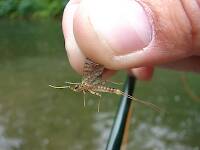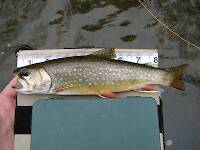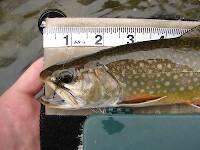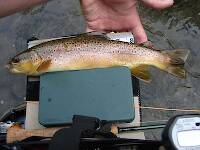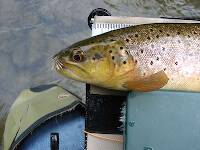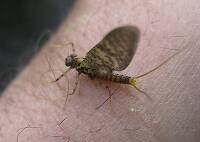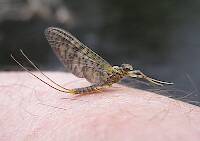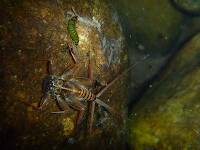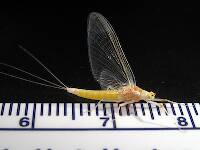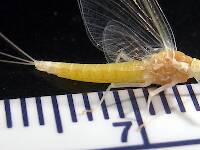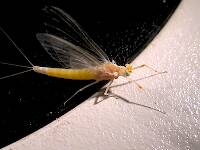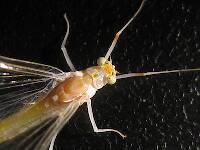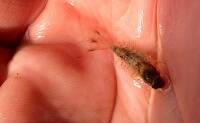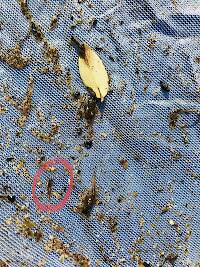
Salmonflies
Pteronarcys californica
The giant Salmonflies of the Western mountains are legendary for their proclivity to elicit consistent dry-fly action and ferocious strikes.
Featured on the forum

This one was surprisingly straightforward to identify. The lack of a sclerite at the base of the lateral hump narrows the field quite a bit, and the other options followed fairly obvious characteristics to Clostoeca, which only has one species, Clostoeca disjuncta.

Troutnut is a project started in 2003 by salmonid ecologist Jason "Troutnut" Neuswanger to help anglers and
fly tyers unabashedly embrace the entomological side of the sport. Learn more about Troutnut or
support the project for an enhanced experience here.
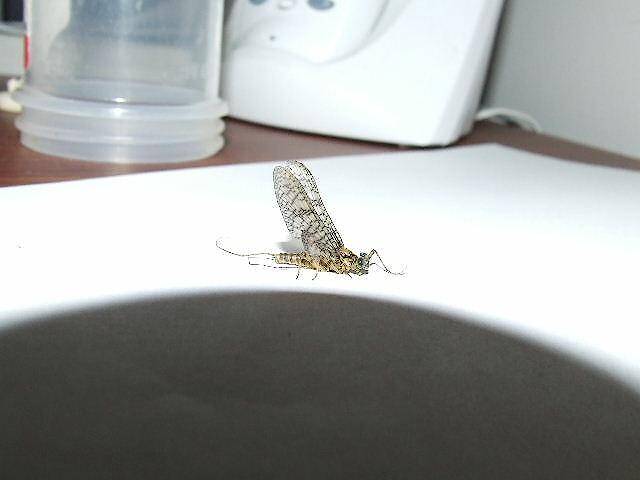
Dryfly on May 28, 2007May 28th, 2007, 2:46 pm EDT
found this lone mayfly amidst a hatch of light hendricksons
(e. invaria) it had 2 tails found may 27in the afternoon
(e. invaria) it had 2 tails found may 27in the afternoon
Dryfly on May 28, 2007May 28th, 2007, 2:49 pm EDT
southeast minnesota
Konchu on May 28, 2007May 28th, 2007, 2:54 pm EDT
hmmm...i don't have my spectacles, but it could be Maccaffertium/Stenonema or perhaps Leucrocuta. what's the size of this beast?
Dryfly on May 28, 2007May 28th, 2007, 3:05 pm EDT
between 14 and 16 mm or probably a size 14 hook
Konchu on May 29, 2007May 29th, 2007, 12:06 am EDT
WITH my glasses (and the size info), you probably do have a Maccaffertium species here. The mostly dark, crowded crossveins of the wings are typical of this genus group. Anyone out there wanna venture a guess about the species ID? Check out the coloration of the abdomen and hind wing.
You know you want to!
You know you want to!
Taxon on May 29, 2007May 29th, 2007, 10:28 am EDT
Okay Konchu, I'll come out and play. I would like to use the clues you provided, but am unable. It is my understanding that (7) Maccaffertium species are present in Minnesota, M. exiguum, M. mediopunctatum mediopunctatum, M. mexicanum integrum, M. modestum, M. pulchellum, M. terminatum terminatum, and M. vicarium. Three or four of them can probably be eliminated based on inadeqate body length. Of those remaining, based largely on emergence date, my guess would be Maccaffertium vicarium.
Quillgordon on May 29, 2007May 29th, 2007, 11:49 am EDT
Taxon,
'Dryfly' stated it seemed to be a size 14/16. Isn't E. vicarium about a size 10.
The photo of the insect looks like it has an olive tint to me.
If so, doesn't that rule out E. vicarium?
Perhaps it could be M.modestum, M.mexicanum, or M.luteum.
John
'Dryfly' stated it seemed to be a size 14/16. Isn't E. vicarium about a size 10.
The photo of the insect looks like it has an olive tint to me.
If so, doesn't that rule out E. vicarium?
Perhaps it could be M.modestum, M.mexicanum, or M.luteum.
John
Flyfishing is a state of mind! .............. Q.g.
C/R........barbless
C/R........barbless
Dryfly on May 29, 2007May 29th, 2007, 12:30 pm EDT
quillgordon
I mislead you when I said it was a 14 or 16, size 12 probably would have been more appropriate
thanks for your replies I was thinking vicarium also just wanted to know what you experts thought
I mislead you when I said it was a 14 or 16, size 12 probably would have been more appropriate
thanks for your replies I was thinking vicarium also just wanted to know what you experts thought
Taxon on May 29, 2007May 29th, 2007, 3:39 pm EDT
John-
The Biology Of Mayflies lists adult body lengths as follows:
Stenonema fuscum (Maccafertium vicarium) - 10 mm
S. rivulicolum (M. vicarium) - 10 mm
S. vicarium (M. vicarium) - 12-14 mm
So, it would appear the adult body length range for M. vicarium would be (at least) 10-14 mm, which in standard dry fly hook size, would be #13 (half way between #14 and #12) to perhaps #8.
Isn't E. vicarium about a size 10.
The Biology Of Mayflies lists adult body lengths as follows:
Stenonema fuscum (Maccafertium vicarium) - 10 mm
S. rivulicolum (M. vicarium) - 10 mm
S. vicarium (M. vicarium) - 12-14 mm
So, it would appear the adult body length range for M. vicarium would be (at least) 10-14 mm, which in standard dry fly hook size, would be #13 (half way between #14 and #12) to perhaps #8.
Konchu on Jun 1, 2007June 1st, 2007, 4:40 pm EDT
The abdomen looked like terminatum to me, but with a little book work, the size more or less rules it out (too big). Vicarium may be as close as we can get without other views of the beast. Who wants to argue? I'm game...
Taxon on Jun 1, 2007June 1st, 2007, 8:16 pm EDT
Dryfly-
I'd like a clarification concerning specimen length. I assume the above quote means you now believe the body length, from front of head to end of abdomen (excluding tails), to be ~12 mm, rather than between 14 and 16 mm, as you originally stated. Is that correct?
Perhaps you could measure the diameter (in mm) of the clear vial behind the specimen, and then divide by 2, as container's diameter appears to be approximately twice the body length of the specimen.
I mislead you when I said it was a 14 or 16, size 12 probably would have been more appropriate
I'd like a clarification concerning specimen length. I assume the above quote means you now believe the body length, from front of head to end of abdomen (excluding tails), to be ~12 mm, rather than between 14 and 16 mm, as you originally stated. Is that correct?
Perhaps you could measure the diameter (in mm) of the clear vial behind the specimen, and then divide by 2, as container's diameter appears to be approximately twice the body length of the specimen.
Dryfly on Jun 2, 2007June 2nd, 2007, 4:05 am EDT
I meant a size 12 hook, so 14mm to 16mm would still be correct
Taxon on Jun 2, 2007June 2nd, 2007, 5:03 am EDT
Dryfly-
A standard size #12 dry fly hook would be used to imitate a specimen with a body length of 9-10 mm, not one with a body length of 14-16 mm.
Is it possible for you to measure the diameter of the clear vial that appeared behind your specimen? I believe that would result in a more accurate measure, than would estimating hook size, and then attempting to convert to mm of body length.
A standard size #12 dry fly hook would be used to imitate a specimen with a body length of 9-10 mm, not one with a body length of 14-16 mm.
Is it possible for you to measure the diameter of the clear vial that appeared behind your specimen? I believe that would result in a more accurate measure, than would estimating hook size, and then attempting to convert to mm of body length.
Taxon on Jun 2, 2007June 2nd, 2007, 5:16 am EDT
Konchu-
Although I am unable to resist your offer, before engaging in more fun (but probably fruitless) discussion concerning species, I'd really like to firm up the specimen body length issue with Dryfly.
Incidentally, would you agree that the specimen is (most likely) a female imago?
Although I am unable to resist your offer, before engaging in more fun (but probably fruitless) discussion concerning species, I'd really like to firm up the specimen body length issue with Dryfly.
Incidentally, would you agree that the specimen is (most likely) a female imago?
Dryfly on Jun 2, 2007June 2nd, 2007, 9:21 am EDT
I measured the container and it was 46 mm wide so it would be 23 mm but probably a little less than 23. It was a male. Sorry I couldn't get any better pictures.
Taxon on Jun 2, 2007June 2nd, 2007, 10:26 am EDT
Dryfly-
Thanks for trying. I was thinking the container might be close enough to the specimen to not have been seriously reduced in perspective by being further away, but I am obviously mistaken.
So, reverting to the previous method of length determination, if you are convinced that it would be a hook size #12, then let's go with a body length of 9-10 mm.
I assume you concluded it was a male because it had claspers, which I was unable to see from your photo. If so, then I must also be wrong about the lifestage, as the forelegs appear way too short for it to a male imago (spinner), so it must have been a male subimago (dun).
Thanks for trying. I was thinking the container might be close enough to the specimen to not have been seriously reduced in perspective by being further away, but I am obviously mistaken.
So, reverting to the previous method of length determination, if you are convinced that it would be a hook size #12, then let's go with a body length of 9-10 mm.
I assume you concluded it was a male because it had claspers, which I was unable to see from your photo. If so, then I must also be wrong about the lifestage, as the forelegs appear way too short for it to a male imago (spinner), so it must have been a male subimago (dun).
Dryfly on Jun 2, 2007June 2nd, 2007, 11:20 am EDT
taxon
Thanks for your tries at indentifying this mayfly. It molted into a spinner after i took the pictures. It had claspers. My informaton is probably too vague to narrow it down too species. oh well
Thanks for your tries at indentifying this mayfly. It molted into a spinner after i took the pictures. It had claspers. My informaton is probably too vague to narrow it down too species. oh well
Quick Reply
Related Discussions
Topic
Replies
Last Reply
5
May 20, 2009
by GONZO
by GONZO
8
Jun 5, 2007
by Dinerobyn
by Dinerobyn
3
Sep 4, 2012
by Entoman
by Entoman
8
Mar 30, 2012
by Brookyman
by Brookyman
4
Nov 19, 2017
by Btbo32
by Btbo32




